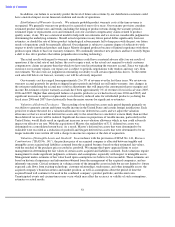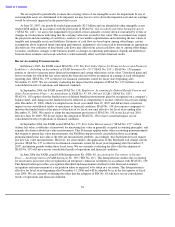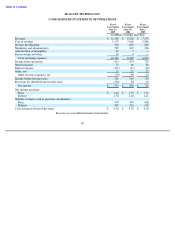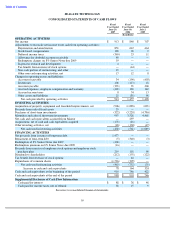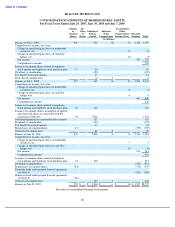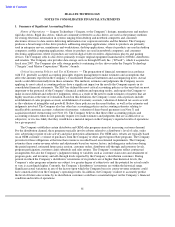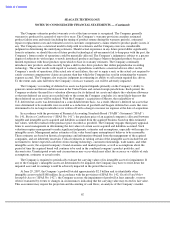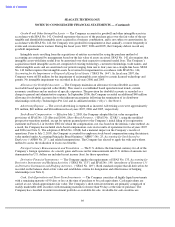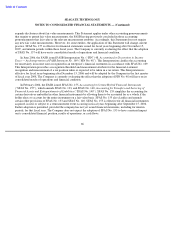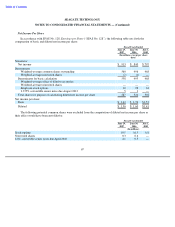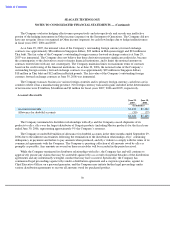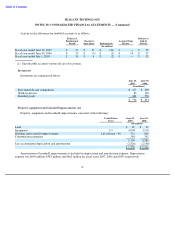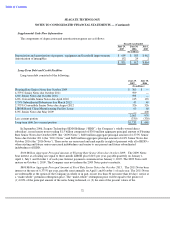Seagate 2006 Annual Report Download - page 66
Download and view the complete annual report
Please find page 66 of the 2006 Seagate annual report below. You can navigate through the pages in the report by either clicking on the pages listed below, or by using the keyword search tool below to find specific information within the annual report.
Table of Contents
SEAGATE TECHNOLOGY
NOTES TO CONSOLIDATED FINANCIAL STATEMENTS — (Continued)
capitalization and the estimation of the fair values of tangible and intangible assets and liabilities. Estimates of cash
flow are based upon, among other things, certain assumptions about expected future operating performance;
judgment is also exercised in determining an appropriate discount rate. The Company
’s estimates of discounted cash
flows may differ from actual cash flows due to, among other things, economic conditions, changes to the business
model, or changes in operating performance. Significant differences between these estimates and actual cash flows
could materially affect the Company’s future financial results.
Basis of Presentation and Consolidation — The consolidated financial statements include the accounts of the
Company and all its wholly-owned subsidiaries, after elimination of intercompany transactions and balances.
The Company operates and reports financial results on a fiscal year of 52 or 53 weeks ending on the Friday
closest to June 30. Accordingly, fiscal years 2007, 2006 and 2005 comprised 52 weeks and ended on June 29, 2007,
June 30, 2006 and July 1, 2005, respectively. All references to years in these notes to consolidated financial
statements represent fiscal years unless otherwise noted. Fiscal year 2008 will be 52 weeks and will end on June 27,
2008.
Revenue Recognition, Sales Returns and Allowances, and Sales Incentive Programs — The Company’
s revenue
recognition policy complies with Staff Accounting Bulletin (“SAB”) No. 104, Revenue Recognition
(“SAB No. 104”). Revenue from sales of products, including sales to distribution customers, is generally recognized
when title and risk of loss has passed to the buyer, which typically occurs upon shipment from the Company or third
party warehouse facilities, persuasive evidence of an arrangement exists, including a fixed price to the buyer, and
when collectibility is reasonably assured. For our direct retail customers, revenue is recognized on a sell-through
basis. Estimated product returns are provided for in accordance with SFAS No. 48, Revenue Recognition When Right
of Return Exists . The Company also adheres to the requirements of Emerging Issue Task Force (“EITF”)
No. 01
-09 Accounting for Consideration Given by a Vendor to a Customer , (“EITF No. 01-09”) for sales incentive
programs. The Company follows Financial Accounting Standards Board (“FASB”) Technical
Bulletin 90-1, Accounting for Separately Priced Extended Warranty and Product Maintenance Contracts for sales of
extended warranties.
Estimated reductions to revenue for sales incentive programs, such as price protection, and sales growth
bonuses, are recorded when revenue is recorded. Marketing development programs are either recorded as a reduction
to revenue or as an addition to marketing expense depending on the contractual nature of the program and whether
the conditions of EITF No. 01-09 have been met.
Product Warranty — The Company warrants its products for periods ranging from one year to five years. A
provision for estimated future costs relating to warranty returns is recorded when revenue is recognized and is
included in cost of revenue. The Company offers extended warranties on certain products that customers may
purchase. Deferred revenue in relation to extended warranties has not been material to date. Shipping and handling
costs are also included in cost of revenue.
Inventory — Inventories are valued at the lower of cost (which approximates actual cost using the first-in, first-
out method) or market. Market value is based upon an estimated average selling price reduced by estimated cost of
completion and disposal.
Property, Equipment, and Leasehold Improvements —
Land, equipment, buildings and leasehold improvements
are stated at cost. The cost basis of assets acquired in the Maxtor business combination was based on estimated fair
values at the date of acquisition (see Note 10). Equipment and buildings are depreciated using the straight-line
method over the estimated useful lives of the assets. Leasehold improvements are amortized using the straight-line
method over the shorter of the estimated life of the asset or the remaining term of the lease. The cost of additions and
substantial improvements to property, equipment and leasehold improvements are capitalized. The cost of
maintenance repairs to property, equipment and leasehold improvements is expensed as incurred.
63


